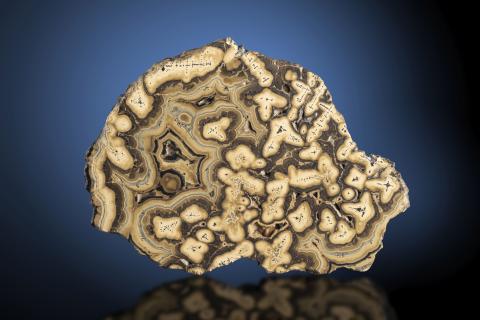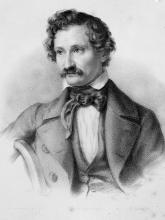History
The Ore Deposit Collection has its roots in three sub-collections created by Abraham Gottlob WERNER (1749-1817). He called them the "physical" mineral collection, the "geographical" mineral collection or "suite collection" and the "economic" mineral collection. They were components of his mineral cabinet. After WERNER's death, the geoscientific education was divided into mineralogy (oryctognosy) and geology (geognosy). Thus Carl Amandus KÜHN (1783-1848), who was appointed to the Mining Academy in 1816 to support WERNER, began to build up a geognostic collection in 1818, which was considerably expanded by Karl Friedrich NAUMANN's (1797-1873) and Bernhard v. COTTA's (1808-1879) documentary material from numerous mapping projects and stays abroad. Alfred Wilhelm STELZNER (1840-1895) formed the material into an ore deposit collection, which was later further systematised by Richard BECK (1858-1919). Friedrich SCHUMACHER (1884-1975) added extensive collections of foreign deposits. He reorganised the deposit collection and systematically developed it into a unique teaching aid.
With the establishment of the Chair of "Deposit Theory", Oskar Walter OELSNER (1902-1963) took over the scientific supervision of the collection. The rapid development of the geological sciences in the 1960s and 1970s led to new approaches and ways of working in the field of deposit research and geology. Under the direction of Ludwig BAUMANN (born 1929), the collection was completely reorganised from 1972 to 1976 on the basis of his teaching concept.
During the creative period of O.W. OELSNER and L. BAUMANN, the Bergakademie was able to take over important holdings from other geoscientific institutions, such as the Historical Freiberg Collection.Other important additions in 1991 were the collection of the "Einheit" mine in Elbingerode, the sample collection of Uranerz Bonn GmbH and a collection of specimens from the former SDAG Wismut. Substantial collections of specimens were brought in through the deposit research excursions to Norway, Sweden, South Africa, Zimbabwe, Namibia and Spain.
Collection
The Ore Deposit Collection includes very valuable historical holdings, including the Freiberg mining district collection, the Annaberg-Marienberg mining district collection and the Schneeberg mining district collection. The deposit collection of solid mineral raw materials comprises approx. 71,000 items from more than 2,600 different deposits and occurrences. A further approx. 80,000 items are part of the magazine collection. There are also two special collections, the "Saxonia" collection with approx. 5,000 items and the uranium collection with approx. 15,000 items.
History
The Ore Deposit Collection has its roots in three sub-collections created by Abraham Gottlob WERNER (1749-1817). He called them the "physical" mineral collection, the "geographical" mineral collection or "suite collection" and the "economic" mineral collection. They were components of his mineral cabinet. After WERNER's death, the geoscientific education was divided into mineralogy (oryctognosy) and geology (geognosy). Thus Carl Amandus KÜHN (1783-1848), who was appointed to the Mining Academy in 1816 to support WERNER, began to build up a geognostic collection in 1818, which was considerably expanded by Karl Friedrich NAUMANN's (1797-1873) and Bernhard v. COTTA's (1808-1879) documentary material from numerous mapping projects and stays abroad. Alfred Wilhelm STELZNER (1840-1895) formed the material into an ore deposit collection, which was later further systematised by Richard BECK (1858-1919). Friedrich SCHUMACHER (1884-1975) added extensive collections of foreign deposits. He reorganised the deposit collection and systematically developed it into a unique teaching aid.
With the establishment of the Chair of "Deposit Theory", Oskar Walter OELSNER (1902-1963) took over the scientific supervision of the collection. The rapid development of the geological sciences in the 1960s and 1970s led to new approaches and ways of working in the field of deposit research and geology. Under the direction of Ludwig BAUMANN (born 1929), the collection was completely reorganised from 1972 to 1976 on the basis of his teaching concept.
During the creative period of O.W. OELSNER and L. BAUMANN, the Bergakademie was able to take over important holdings from other geoscientific institutions, such as the Historical Freiberg Collection.Other important additions in 1991 were the collection of the "Einheit" mine in Elbingerode, the sample collection of Uranerz Bonn GmbH and a collection of specimens from the former SDAG Wismut. Substantial collections of specimens were brought in through the deposit research excursions to Norway, Sweden, South Africa, Zimbabwe, Namibia and Spain.
Collection
The Ore Deposit Collection includes very valuable historical holdings, including the Freiberg mining district collection, the Annaberg-Marienberg mining district collection and the Schneeberg mining district collection. The deposit collection of solid mineral raw materials comprises approx. 71,000 items from more than 2,600 different deposits and occurrences. A further approx. 80,000 items are part of the magazine collection. There are also two special collections, the "Saxonia" collection with approx. 5,000 items and the uranium collection with approx. 15,000 items.





